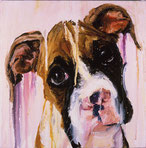
A WORD ABOUT THE FIRST CHILDREN PAINTINGS
The paintings of children came about because I was looking for subject matter that operated on the viewer the way the dogs did. Dogs, it goes without saying, are real breathing animals. We look at them, they at us, and a bond inevitably forms—as all dog owners will attest. And I was aware that a large measure of the appeal of the dog paintings was the connection the viewer made with the dog itself. Early on, it occurred to me that something else was happening as well, and it didn’t take long before my suspicions were confirmed. Visitors to my studio told me that they couldn’t help but picture the dog’s owner. Maybe this was inevitable: after all, a fluffy little poodle tends to suggest a different back-story than does a junkyard pit bull. So the dog paintings were—in a sense—double portraits: one of an animal depicted, one of an owner imagined. Put another way: the dog paintings occupied an art historical crossroad; they combined portraiture (which is largely about the construction of identity) with still-life (which is a essentially a record of possessions and an imagined possessor).
Children seemed to be a subject matter that would extend this same interaction between two genres. Firstly, the children were—like the dogs—real breathing animals. You looked at them, they at you, and—a bond formed—as any parent will attest. Secondly, children at the ages I painted them likely didn’t exercise much autonomy; the clothes and hairstyles depicted in the paintings were a reflection of their parents, not them. This is parallel to the way, in the dog paintings, that the dog’s collar or hair ribbon reflected the dog owners, not the dogs. So the paintings of children were also portraits of someone not there. In other words, the children paintings, operated as both still-life and portraiture. True, children aren’t owned the way that dogs are, but they still allowed me to create paintings that suggested the double narrative of two distinct genres.
The children though, also allowed me to extend my concerns because these paintings allowed me to introduce the concepts of time and nostalgia to my work--neither of which had really been an element before. One tactic I deployed to this end was to faithfully reproduce the color shifts in old photographs. If you look at the painting of Benjamin above, you'll see that there are almost no reds in the painting. This was because the reds in the source photo--a 20-year-old elementary school photograph--had almost completely faded with exposure to sunlight. You can see similar color shifts in the other three paintings I made that year, although they aren't as pronounced.
Color shifts like this become increasingly important in the next few years, as a look ahead will show. Additionally, the subject matter of children lends the physicality of my runny, drippy paint a different psychological and emotional charge than exists in the dog paintings--as a look ahead will also demonstrate.
 andrew ehrenworth
andrew ehrenworth
